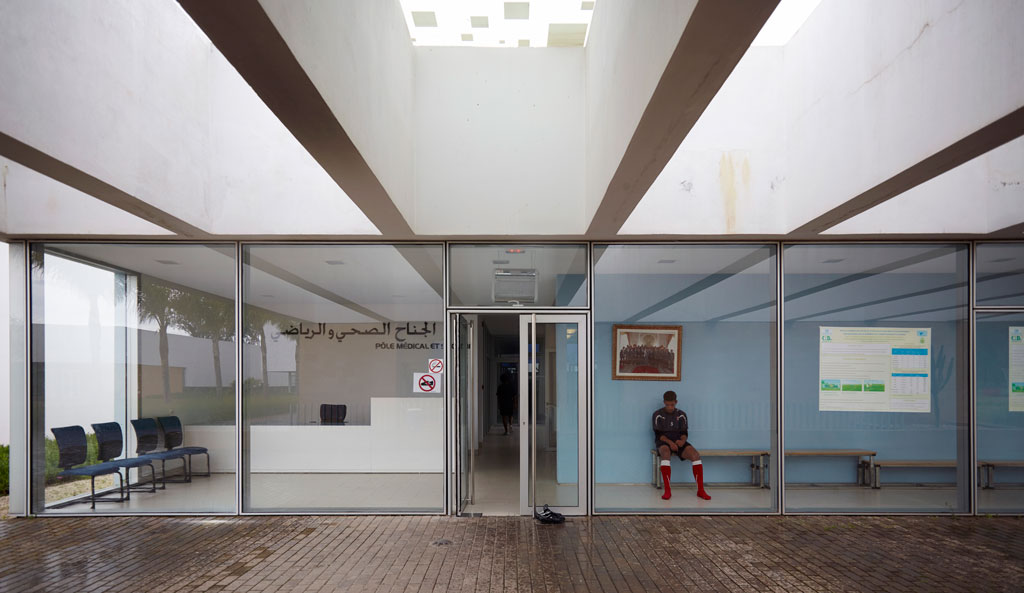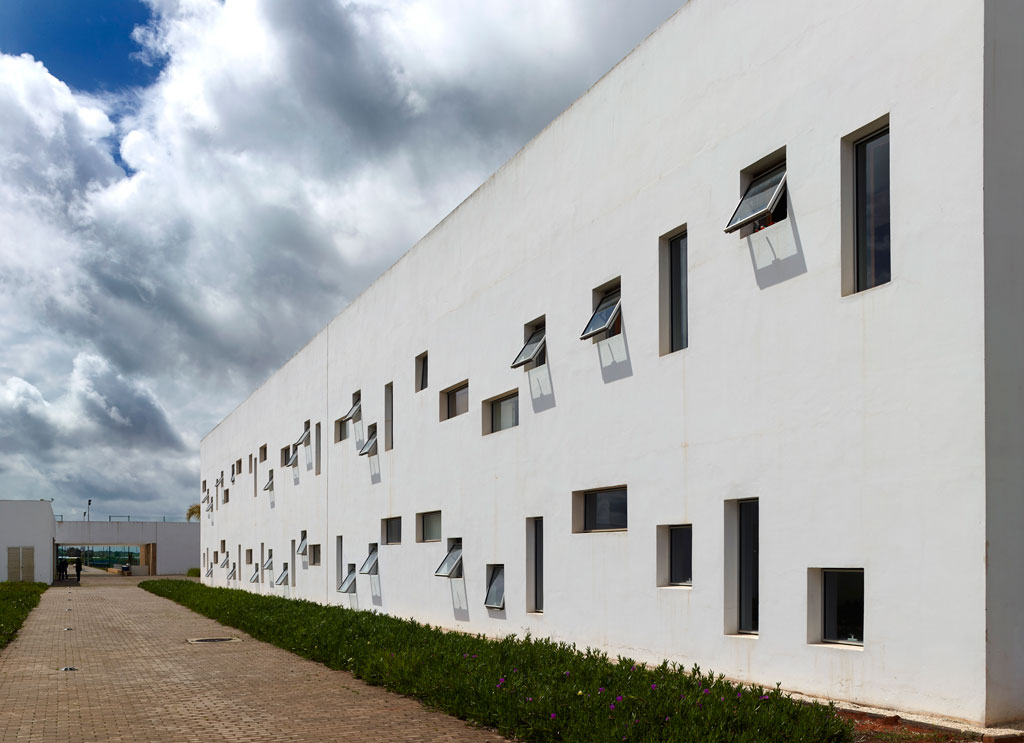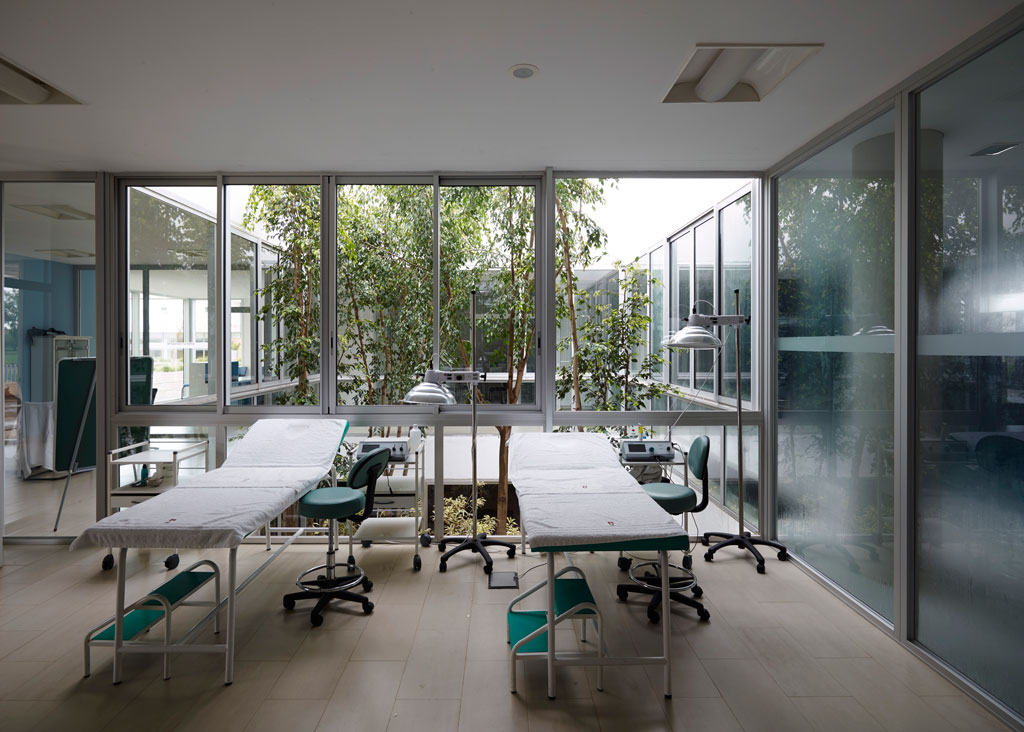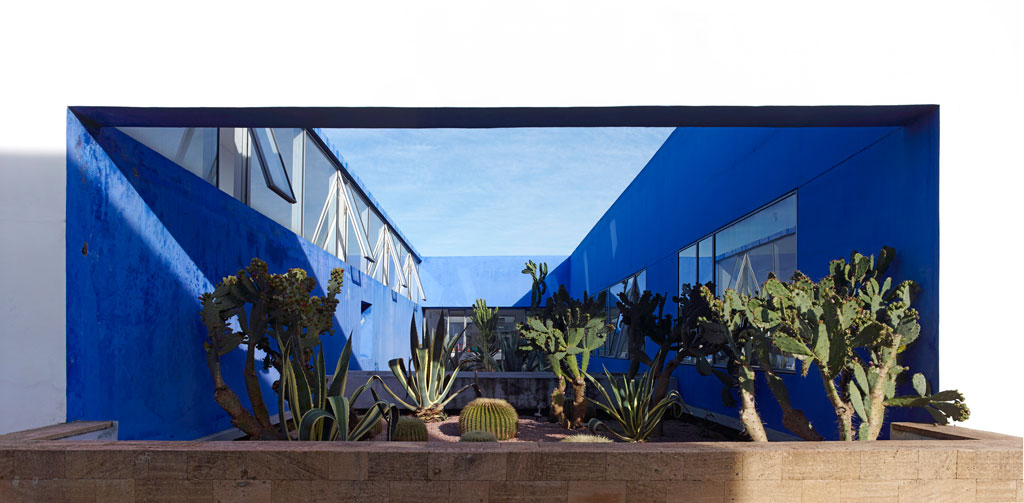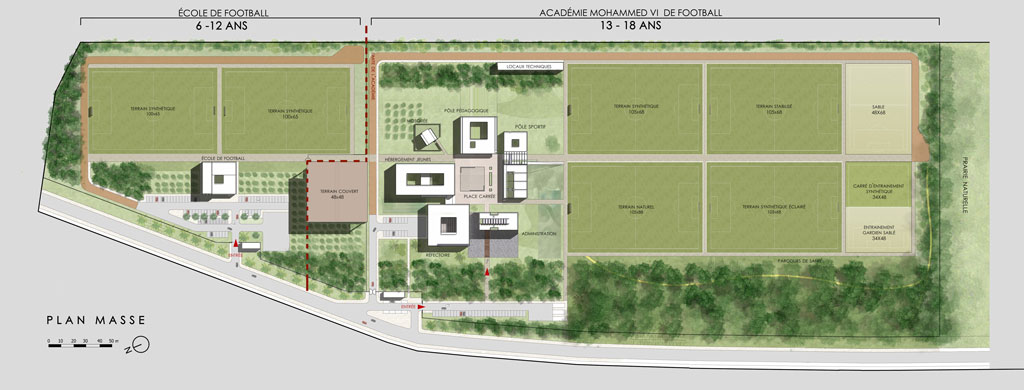-
Mohammed VI Football Academy/ Groupe 3 Architectes
Architects:
Groupe 3 Architectes
Location: Salé,
Morocco
Project Year: 2010
Photographer: AKAA/ Cemal Emden/ Groupe 3 Architectes
User: Académie Mohammed VI de Football
Project manager: Compagnie Générale Immobilière
Landscaper: MB Paysage
Engineers: NOVEC
Completed: 2010
Design: 2007-2008
Site size: Total combined floor area: 9,000 m2 - Total site area: 2,500,000 m2
-
- 15 May 2015

- Billy Mwangi
- Training , Recreation , Modernism , Modern Africana , Education Centres ,
The Mohammed VI Football Academy located in Salé, on the right bank of Bouregreg River, opposite the capital Rabat is a private academy that offers education, schooling and Football. The Academy was initiated and partially financed by personal funding from the King of Morocco in 2006, with an aim to raise the ranking of national football to the top of the Africa charts and compete at international level. This was led by a diagnosis which found out that the Moroccan football was in a bleak state not for the lack of talent but due to the lack of training facilities.

The King commissioned Groupe 3 Architects to design a football training academy for around 60 13 to 18 year olds, many from underprivileged areas of Rabat, which would provide rigorous football training but still offer school education.
The brief was to design a functional and efficient tool that can compete with the training centres of the best European clubs by adapting it at the same time to the cultural and social specifics of the population concerned.

The Academy is designed in a way that encourages both focus and a sense of community through its arrangement like that of a traditional douar (hamlet). The douar has a central ‘village square’ around which stand five buildings which accommodates administrative, sports, teaching, lodging and catering functions. The buildings have central landscaped patios for relaxation whose walls are each painted a colour that reflects an aspect of Morocco, with the buildings’ massive exteriors being a sober white.

The complex uses local ochre earth ties the complex to its environment, and is textured with gravel, river stones, concrete paving and timber decking.
From the architects:
The vision was about a whole fragmented into parts. The whole is the douar (hamlet-village) typology with a central heart, while the parts are the building units inspired by traditional home typologies.

These buildings are each differentiated by their functional roles. These functional identities are the main players in determining the relations between the building and the outside surroundings: open/closed, interior/exterior, white/colour, work/rest, introverted gardens/vast open landscape.
The exterior presents a composition of white, plain and massive surfaces, carefully pierced to respect.

light, thermal flows, wind and views. The massive white walls are interlaced with a local stone, pierre de Salé, an ochre earth tan that ensures the continuity of the buildings and ties them more to their environment. The material and colour of the stone organise the relation between the exterior and interior of the buildings, penetrating more profoundly in some, and tying a whole chromatic palette together: the grey gravel, concrete floors, white colour of the volumes and the greens of the landscape.

In contrast, on the inside each building has a patio, a central landscape for relaxation. The patio walls are each painted in a dominant colour that reflects an aspect of Morocco: the blues of the ocean or of Chefchaouen alleys; the ochre of the south; the greens of fertile plains.
From the young trainees:
It is “the” place to be, where our hopes can materialise. Families, parents and kids dream of being part of the Academy. The formula of taking care of their young ones from a medical, sports, educational and financial standpoint is a great privilege that many families seek.
Rabat-Salé Urban Infrastructure Project, Hassan II Bridge / Marc Mimram Architecture
The Rabat-Salé Infrastructure Project is part of a 6,000 hectares development of the Bouregreg Valley which aims to rehabilitate and promote the banks of the Bouregreg River to offer a pleasant place to live for the people of Rabat and Salé.
SHARE YOUR THOUGHTS
-
If you want your own avatar and keep track of your discussions with the community, sign up to archiDATUM >>
SELECTED WORKS
-

Highlighting the key elements of architecture as design, details, computers and people, Henning Rasmuss, a practicing architect with Para...
-

- Butaro Doctor’s Housing/ MASS Design Group
- 11 Jun 2015
Mass Design Group’s zeal to offer architectural solutions that impact beyond the basic concepts of a building can sequentially be observe...
-

- Alliance Franco-Senegalaise / Patrick Dujarric
- 19 Jan 2016
Built to house the Alliance Française, and to provide the provincial town of Kaolack with much needed library space, meeting areas, and c...
CONTEMPORARY AFRICAN DIRECTORY
-

- House Al Hamra / Atelier KOE
- 27 Jan 2016
Atelier KOE found the response to both the architectural aesthetic as well as energy autonomy. The spacious residence, built entirely wit...
-

Christian Benimana wants to build a network of architects who can help Africa's booming cities flourish in sustainable, equitable ways --...
-

- Constantine Exhibition Centre / PTW Architects
- 05 May 2015
Africa is rising, from a slow economic downturn to a possible intimation in coming years and what better way to express that than through...
ARCHIDATUM BROWSER
-
-
-
category
Africana Apartments archiDATUM Audio ArchiDATUM Dates archiDATUM Jobs archiDATUM News archiDATUM Talks ArchitectsArchitects + Spaces Architecture Art Articles Books & Magazines Books & Magazines Centres City Planning CommercialCommercial Centres Communal Centres Competitions Conservation Conservation Architecture Contemporary Contemporary African Directory Editor's ChoiceEducation Centres Events Faculty Years Financial Gated Communities Health Centres Hotels Human AnatomyTechnology Traditional Training Transit Oriented Urban Urban Architecture Videos Weekly Round Up: Architecture in AfricaTaxi Ranks Obituary African Greats Concept Store Lifestyle Luxury Stores African Modernity Ideas of InterestAfrican Modernism Pritzker Prize Makers of a Continent Spotlight Pancho Guedes Pin Up Architectural Photography LensSwahili Architecture Contemporary Swahili Women In Architecture Parliaments Exhibition Houses ArchiDiaries Great City Terrible Place -
POPULAR
Datum Antique: Sasaki Associates’ Green Lung of... Falatow Jigisayo Orphanage / F8 Architecture + ... Mapungubwe Interpretation Centre / Peter Rich A...Eko Atlantic City / AR+H Architects House 12 Magnolia Hills / Mehraz Ehsani Msafiri Mwazighe And The White Fields Of Sustai... International Conference Center / CAAU ArchitectsCentre de Santé et de Promotion Sociale/ Kéré A... Dennis Mukuba And The Unbowed Hues of Justice: ... Dakar's International Conference Center / Taban... TechU Ibadan campus / MZ ArchitectsTena Tower-Tena Lakes/ Manuelle Gautrand Nigerian Cultural Centre and Millenium Tower / ... 10 Greenest Buildings in Africa AFGRI Headquarters Office Building/ Paragon Arc...Halawa House / Abdel Wahed El-Wakil Bibliotheca Alexandrina / Snøhetta Mankgaile Limpopo Primary School/ SAOTA Tripoli Convention Centre/ Tabanlıoğlu ArchitectsLagos State Considers ‘Makoko Floating School’ ... Marrakech-Menara Airport Extension/ E2A Archite... US Embassy Maputo/ Allied Works Architecture Dar es Salaam: An Emerging African MetropolisBlock 36, Westown / Shahira H. Fahmy Architects Grand Théatre de Rabat / Zaha Hadid Architects ZHA ArchiDATUM Dates: Issa Diabaté on a Political A... English Point Marina/ Broadway Malyan ArchitectsLibyan European Hospital /Carlo Berarducci Arch... Glover 57 Apartments / Domaine Public Architects National Park of Mali / Kere Architecture George Yagomba And A Sail Across Diplomacy: Par...Botswana Innovation Hub/ SHoP Architects Mayotte Airport / REC Architecture Goma Catholic Cathedral/ Lexicon + Ion Architects National Theater of Equatorial Guinea / Indepen...Mopti Centre For Earth Architecture / Kere Arch... ArchiDATUM Dates: SAOTA's Greg Truen On Modern ... Kwame Nkrumah Presidential Library/ Mario Cucin... Why Abandon The Mud Hut: Joe Osae-Addo and affi...Universidade Agostinho Neto / Perkins + Will Ar... The CAD Enigma: The Backlash Within Architectur... Windmills Chapel / Koop Design Don Bosco Catholic Church/ Space and Systems Ar...The Technology School of Guelmim/ Saad El Kabb... Sinthian Thread Arts Cultural Centre / Toshiko ... Concrete Beauty: Towards an Architectural Language KE Ochieng/SAOTACollege Ouangani, Mayotte/ TERRENEUVE architects Sipopo Congress Center / Tabanlıoğlu Architects Casa Port Railway Station/ AREP Karura Forest Environmental Education Centre / ...Umubano Primary School/ MASS Design Great City Terrible Place: Future of Island Cities Alexandra Interpretation Centre / Peter Rich Ar... Benga Riverside Residential Community / Kere Ar...Warka Water/ Architecture and Vision - Arturo V... Glass House/ Nico Van Der Meulen Architects South African Embassy, Addis Ababa/ MMA Design ... Blair Atholl House / Nico Van Der Meulen Archit...Opera Village Laongo/ Kéré Architecture Aloe Ridge House/ Metropole Architects Controversy Sells: In Defence of the One Finger... Gando Primary School / Kéré ArchitectureCalabar International Conference Center/ Hennin... Classrooms for University of Namibia/ Wasserfal... Head Office Ernst & Young / Wasserfall Munting ... Aveni-Re Building/ Koffi & Diabaté ArchitectesBMCE Branches / Foster + Partners Architecture of African Origin: Beyond the Dist... Kigali: A City’s Rebirth Into The 21st Century Constantine Exhibition Centre / PTW ArchitectsNIB Mixed Use / Xavier Vilalta Architects Ahmed Baba Institute of Higher Islamic Studies ... The Boma Hotel/ Morphosis Architects Soweto Theatre / AfritectsHouse Serengeti/Nico van der Meulen Dedan Kimathi Monument/ School of Fine Art, Ken... Kituo Cha Sheria/ Morphosis Architects FOCHTA Vocational Training Centre/Sam Crawford ...Baragwanath Transport Interchange and Traders M... Equatorial Guinea Ministry of Mines, Industry a... Butaro Doctor’s Housing/ MASS Design Group Ardhi University/ University of Dar es SalaamAbdel Wahed El-Wakil / The Benefits of Traditio... New British High Commission / Kilburn Nightinga... The Mauritius Commercial Bank Ebene / Jean Fran... Central Catering Unit/ Dalgliesh Marshall JohnsonTaroudant University / Saad El Kabbaj, Driss Ke... Ouagadougou International Airport / ENIA Archi... Rabat-Salé Urban Infrastructure Project, Hassan... New Rugo Social Housing / George Pericles Archi...Africa Needs Glass Architecture; Or Does It? 30 Jellicoe Avenue/ Paragon Architects El Gouna Hotel Resort / Michael Seagraves Archi... OVD 919/ SAOTAArchitecture Of African Origin (AOAO): Isn’t th... Villagio Vista / Allford Hall Monaghan Morris Great Mosque of Touba / Tashiko Mori Riviera Apartments / Domaine Public ArchitectsModern House: Slow Death of African Informal Se... The Teodoro Obiang Nguema Mbasogo Presidential ... Adeline Gruber on Translating the Man Made : An... Rwinkwavu Neonatal Intensive Care Unit / Mass D...Durban Beach Front Redevelopment / Design Works... Cove 3 – Pezula Knysna/ SAOTA French School Group Jean Mermoz / Terreneuve A... Film + Architecture: What it Holds for AfricaThe Taita Sustainable Vernacular House Mama Sarah Foundation School/Kere Architecture Butaro Hospital/ MASS Design Group Long Beach Resort / Stauch Vorster ArchitectsMaking Africa A Continent of Contemporary Design Jarred Pincus and the Fortress of Faith: Archit... AACCSA Headquarters / BC Architects WAF 2015 African Projects ShortlistThe Amphitheatre of El Jem/ The Roman Empire Green Buildings Sprouting Up in Nairobi, Kenya Mtamu Kililo and the Brick by Brick Battle in t... African Design Center; “Bauhaus of Africa”ArchiDATUM Dates: Joe Osae-Addo on Competition ... ArchiDATUM Dates: Paragon's Henning Rasmuss on ... Grand Mosque of Algiers / KSP Jürgen Engel Arch... University Campus Denis Sassou Nguesso/ IADCorner Jellicoe Avenue and Oxford Road / Parago... Old is-Gold Throwback: Photographic Chronology ... Catholic University Of East Africa Learning Res... Courtyard Houses / Jean-François ZevacoRegulation for Postal Communication Authority A... Jomo Kenyatta Statue/ James Butler French Diplomatic Campus in Nairobi/ TERRENEUVE... Hilton Hotel Windhoek/ Wasserfall Munting Archi...Abilonino Community Polytechnic/ Lexicon + Ion ... The Plight of African Vernacular Architecture Office of The Auditor General/ Wasserfall Munti... Old is-Gold Throwback: Photographic Chronology ...Art or Farce: Africa Renaissance Monument in Da... Protect African Heritage: Who Really Cares? Vaal Studio / Elphick Proome Architects New Algerian Parliament / Bureau Architecture M...School Brousse-Besely/ Jean-Paul Viguier & Asso... Joe Osae Addo on the Connecting Tissues of Resi... Johannesburg: The City of Gold Makoko Floating School/ NLÉUpeo Camp, Lake Jipe / Urko Sanchez Architects Confessions Of A Critic: Architecture The Lady 21° House at Msasani Village/ Tharani Associates Naomba, Naomba/ Nadir TharaniBritish Council Building /Emma Vergette Architectural Language: The Myths and The Reality 102 Rivonia Deloitte Head Office / Boogertman +... Circa Gallery on Jellicoe / studioMASThe Assinie-Mafia Catholic Church / Koffi & Dia... Who Cares For Non Showy Architecture? Autodesk Kenya Live Mzamomtsha Primary School/ SAOTAHamilton Fountain/ Judiciary Service Commission Bloomsbury Waterfront Development/ NLé Works Australian High Commission / Planning Systems S... Zliten Al-Asmariya University For Islamic Scien...Primary School Tanouan Ibi / LEVS Architecten Cove 6 – Pezula Knysna/ SAOTA Crafting Kenya: A Photographic Journey Of Kenya... Aga Khan Hospital MRI Radiology and Physiothera...Mutende II/ Orkidstudio Want to be a Starchitect? Come, Sit Down and Li... Archi Porn: The Soulless Playback That is Archi... Dr. Barrack Residence/ Heritage AssociatesGIfA Awards for Architecture 2015 Azur Pavilion/ Koffi & Diabaté Architectes Women's Centre/ Hollmén Reuter Sandman Architects Mohammed VI Football Academy/ Groupe 3 ArchitectesSarah De Villiers And The Fantastical Realm of ... Great City or Terrible Place: Experiencing Lamu SOS Children´s Village in Tadjourah / Urko Sanc... The Epping Road Long House/ Studio MASArchiDATUM Dates: Amyas Cornell and his Rebelli... Sandibe-Okavango Safari Lodge / Nicholas Plewma... Boogertman + Partners Architectural Design Scho... Embassy of the Netherlands / Dick Van Gameren a...Egypt inaugurates Museum of Arabic Calligraphy ... Urban Environment: Engaging Through Travel Datum Antique: Pancho Guedes' Saipal Bakery Evolution of Pedestrian Bridges/ Urban MorphologyWestcliff Estate/ Studio Mas Village Health Works Staff Housing / Louise Bra... Diébédo Francis Kéré: Architecture is a Wake-Up... Lalibela /BC ArchitectsHonoring Wangari Maathai: The Epitome of Sustai... Lokko House / Lesley Lokko Conservation of Architectural Heritage (CAH) Biovac Centre Phase 1 / Studio MasWorking Smarter: Architects and their Apps Woldaya Maternity Centre /Xavier Vilalta Archit... Musau Kimeu: The Philosophy of Environmental De... Mahali Mzuri Safari Camp / Real StudiosMaputo Modernism: A Rachel Jenkins' Photo Essay World Architecture Festival Awards 2015 US Department of State Bujumbura / Perkins and ... Rebel Architecture: On activism in Architecture...11 Irritating Things That Drive Designers Crazy African Wildlife Foundation Ilima School Mass D... Who Is The Architect For The Common Man? H.E. Amb. Martin Kimani on Architecture in AfricaAnidan Clinic/ Urko Sanchez Architects Of Cities & Urban Themes: A case of Zanzibar St... Netherlands Embassy in Mozambique / Kaan Archit... 105 Corlett Drive/Paragon ArchitectsDatum Antique: Giuseppe Pettazzi's Fiat Taglier... ArchiDATUM Dates: Joe Gitau on the Psychedelic ... Infill House / Studio Mas Highveld Pavilion / Studio MasArchitecture Students: Be Competitive Through T... ArchiDATUM Dates: Nikos Salingaros On A Sustain... UIA Road trip Caravan 2014/ Students under the ... Seth Mokitini Methodist Seminary / Boogertman +...Extension Labattoir College in Dzaoudzi/ Archit... Terra 2016: XIIth World Congress on Earthen Arc... Designing City Resilience Biennale Architettura 2014 - Absorbing Modernit...Significant Moments that Changed the African Ar... African Modernism: Architecture As a Nexus of D... Great City or Terrible Place: The Durban Experi... Working on Water: Al JazeeraArchitecture: From Nothing to Something The Lo-Fab Movement 2015 Campaign Meroe Royal Baths Protective Shelter / Kere Arc... Market in Quibala / Michelle Vasconcelos Design...St Jerome’s Children's Centre / Orkid Studio Malabo New St. Isabel International Airport / I... House Mosi/Nico van der Meulen AFRICA - The Architecture, Culture and Identity...Unified Architectural Theory: An Introduction ArchiDATUM Dates: Brad Pettitt and His Philosop... Diébédo Francis Kéré: How To Build With Clay...... ArchiDATUM Dates: Michael Khately and a Propens...Philip Kleijnhans' Architecture's Survival for ... Re-Imagining Nairobi: An Architectural Exhibition Buckminster Fuller Challenge 2015: Finalists An... Architecture for Social Gain Awards 2015 is Fin...Datum Antique: Jean Francois Lamoureux and Jean... 1:54 Contemporary African Art Fair Malabo Basilica / Saraiva-Associados Call for Proposals: Expo Milano 2015Centre pour le Bien-être des Femmes/ FARE Studio Visualizing the Future of the City/CAA Students... Everyone is an Accomplice/Nadir Tharani Library for the Community of Muyinga / BC Arch...Waiting for Your ‘Big Break’: My Two cents Pancho Guedes, A “Legend of African Modernism A... RIBA Norman Foster Travelling Scholarship Foster + Partners Ventures into Rwanda with a D...Roman Ridge / Alfredo Resende Architects Women’s Opportunity Center / Sharon Davis Design Brixton Studio House / 26'10 South Architects Offices for Bührmann & Partners / Wasserfall Mu...Taxi Rank No. 2 / 26'10 South Architects Alara Concept Store / Adjaye Associates The Last Glass House / Thomashoff + Partner Arc... Zeitz Museum of Contemporary Art Africa MOCAA /...The Cities of Cogo & Corisco Master Plans / Pag... Icons of a Modern Era: Five Premier African Art... African School of Excellence / Local Studio Politics and Architecture in Africa as Synonyms...British Council, Freetown / Manser Practice Africa Design Center: Training New Generation ... Koudougou Central Market / Swiss Agency for Dev... MNBH Museum of Earth Architecture_Sama and Kasa...British High Commission Tanzania / Manser Practice Maisha Film Garden / Tamassociati Vodafone Site Solution Innovation Centre SSIC /... Datum Antique: Hassan Fathy's New Barris VillageFreedom Park, Phase 1 / GAPP + Mashabane Rose A... Rosebank Lofts / 26’10 South Architects The Elemental Alehandro Aravena Scoops 2016 Pri... One Airport Square / Mario Cucinella ArchitectsFreedom Park Museum / GAPP + Mashabane Rose Arc... Dominican Chapel/ Demas Nwoko In Africa: Architecture Society of China_Part I Finding New Inspirations : Modernism Vs MimicryConcorde Kintélé Sports Complex/ PTW Architects Aon Insurance Headquarters / SPASM Design Archi... Alliance Franco-Senegalaise / Patrick Dujarric How Alehandro Aravena Beat Them All in 2016 : T...The Boogertman + Partners Architectural Design ... Konokono Vaccination and Educational Clinic / S... Datum Antique: Biermann and Theron's Crasulla ... The Outreach Foundation Community Centre / Loca...House Al Hamra / Atelier KOE Revival Sunset Chapel / FATmaison Cohabitation / Kilo Architectures Finding Stories :: The Role of Immaterial Cultu...AfriSam-SAIA Award 4 Sustainable Architecture 2... Move Over, Paul Klee: Pancho Guedes And My Guar... River House / 26'10 South Architects Lost Villa / Jonathan Woolf ArchitectsArchitecture Made In Africa: Unpublished Or Non... How To: The Appropriate Architectural Brief Goderich Surgical Center / TAMassociati Kaedi Regional Hospital / Association Pour Le D...Namibia Offices For Mineworker’s Union / Wasser... British Council Nigeria / Allies & Morrison Lake Muhazi Gahini Church / Light Earth Designs Architectural Sheng: The Good, the Bad and Outr...The Preschool of Aknaibich / BC Architects and ... Rwanda PIH Share Houses / Sharon Davis Design Port Sudan Pediatric Center, Red Sea State / Ta... Butaro Ambulatory Cancer Center/ MASS Design Group -
RECENT
-
ARCHIDATUM VIDEOS
-
MORE FROM Groupe 3 Architectes
EXHIBITIONS,EVENTS AND NEWS
-
OUR INSTAGRAM FEED
FROM OUR FLICKR FEED

- Tweets about archiDATUM
ARCHIDATUM ARCHIVES
RECENT NEWS AND EVENTS
OUR PARTNERS
All Rights Reserved .
All images are © relevant caption














